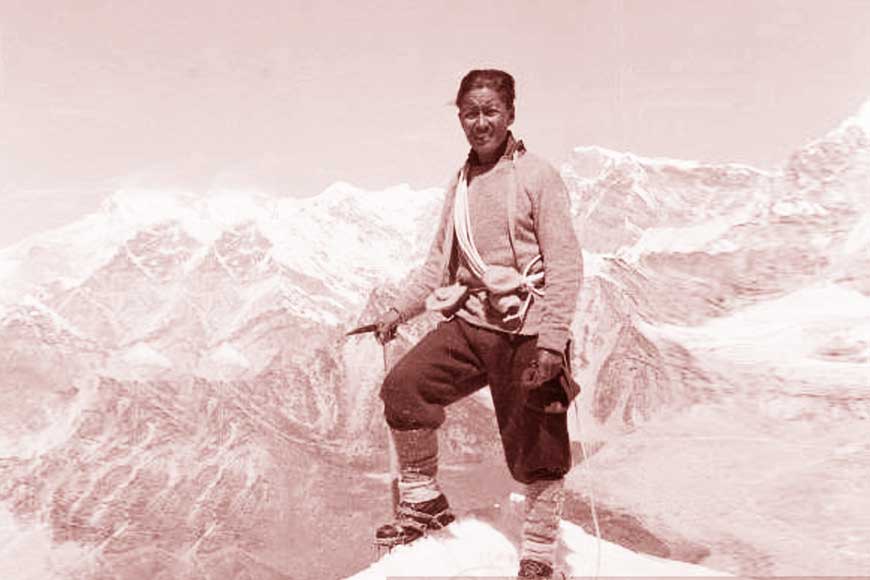The man who made Mount Everest famous

Technically, today is the day the world celebrates the birthday of Sherpa Tenzing Norgay, one of the first two known individuals to summit Mount Everest, along with New Zealander Sir Edmund Hillary on May 29, 1953. Therefore, today is an occasion for twin celebrations: the day two humans reached the highest point on earth, and also the day when one of them was born.
According to renowned mountaineer Debashis Biswas, however, Tenzing himself decided that today was to be his birthday, since there was no real record of his date of birth, except that it was sometime at the end of May 1914. “When he reached the summit on May 29, Tenzing himself decided that today was to be his birthday,” says Biswas, the first Bengali civilian mountaineer to have reached the top of Everest, in 2010.
Tenzing would ask anyone who wished to take a photograph with him for a small sum of money. He would then explain that the money was going into a fund that he was continuously raising for the benefit of his impoverished community.
In a sense, Tenzing Norgay was justified in his choice of birthday. This day represents not just a new life for him, but the beginning of a new chapter in history for the Sherpa community as a whole. Residents of the India-Nepal Himalayan region for millennia, this group of incredibly hardy, dedicated and committed mountain people are unmatched when it comes to knowledge of the Himalayas, as well as high-altitude climbing. And yet, had Tenzing not set foot on the top of Mount Everest on that fateful day, the Sherpa would probably not have gained the global recognition they have.
“Tenzing is like a god for the Sherpas,” says Biswas. “And because people always associate him with Everest, they tend to forget that he had been climbing the Himalayan ranges since the 1930s, and almost reached the Everest summit once earlier.”
Biswas should know, being the only Indian civilian mountaineer to have reached the summit of seven 8,000 m-plus Himalayan peaks - Everest, Kanchenjunga, Lhotse, Makalu, Manaslu, Annapurna, Dhaulagiri. “None of my climbs would have been possible without Sherpas,” he says. “And this holds true for every Himalayan climber. This was Tenzing’s true achievement, he forced the world to see how critical the role of the Sherpas was.”
He did more. Realising that he could use his international fame to improve the plight of the Sherpas, Tenzing would ask anyone who wished to take a photograph with him for a small sum of money. He would then explain that the money was going into a fund that he was continuously raising for the benefit of his impoverished community. Perhaps because he had started out as a porter himself, Tenzing was determined that the world see Sherpas as more than just load-bearing humans who knew their way around the mountains.
Also read : First to record the height of Mt. Everest
“Without belittling anyone, I would say that while Edmund Hillary may or may not have been replaceable on that final push to the summit, Sherpa Tenzing was irreplaceable,” insists Biswas. “Hillary fell into a crevasse in the Khumbu glacier when the route was being opened. Tenzing was right behind him, and literally saved his life.”
According to renowned mountaineer Debashis Biswas, however, Tenzing himself decided that today was to be his birthday, since there was no real record of his date of birth, except that it was sometime at the end of May 1914. “When he reached the summit on May 29, Tenzing himself decided that today was to be his birthday,”
“Tenzing is like a god for the Sherpas,” says Biswas. “And because people always associate him with Everest, they tend to forget that he had been climbing the Himalayan ranges since the 1930s, and almost reached the Everest summit once earlier.” That would be 1947, when Tenzing took part in an unsuccessful summit attempt with Canadian-born Earl Denman, and Ange Dawa Sherpa. The climb ended when a fierce storm hit the party at 22,000 feet (6,700 m).
Born in Tibet, which is the original home of the Sherpas, Tenzing eventually settled in Darjeeling, which today has a sizeable Sherpa population. “His one wish was to live in a place from where he could see Kanchenjunga whenever he opened his window,” says Biswas. Kanchenjunga, considered sacred by the local Lhopo people, is one of the peaks Tenzing never attempted to climb, but kept in his heart forever, until his death in 1986.










